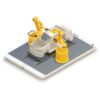Airport Baggage Handling System Market Summary:
Baggage screening systems, such as X-ray scanners and explosive detection systems, play a crucial role in preventing the transportation of prohibited items. The airport baggage handling system market is also driven by the increasing focus on security. With the rising threat of terrorism, airports are investing in advanced screening technologies to ensure the safety of passengers and their belongings. The airport baggage handling system market is a crucial aspect of the aviation industry, ensuring the smooth and efficient movement of luggage from check-in to the aircraft. With the increasing number of air travelers worldwide, airports are constantly striving to enhance their baggage handling systems to meet the growing demand. One of the key drivers of the airport baggage handling system market is the need for improved operational efficiency. Airlines and airports are under immense pressure to reduce baggage mishandling and improve overall customer satisfaction. An efficient baggage handling system can significantly reduce the chances of lost or mishandled luggage, ensuring a seamless travel experience for passengers.
Moreover, advancements in technology have revolutionized the airport baggage handling system market. Automated systems, such as conveyor belts, scanners, and sorting machines, have replaced manual handling, leading to faster and more accurate baggage processing. These systems are equipped with state-of-the-art sensors and tracking devices, enabling real-time monitoring of luggage throughout its journey. The growing trend of self-service check-in and baggage drop-off has further fueled the demand for efficient baggage handling systems. Passengers now have the check-in option online, print their boarding passes, and drop off their luggage at designated self-service kiosks. This not only reduces waiting times but also allows airports to handle a larger volume of passengers. The airport baggage handling system market is witnessing significant growth due to the need for improved operational efficiency, advancements in technology, increased focus on security, and the rise of self-service check-in. As airports continue to expand and air travel becomes more accessible, the demand for efficient baggage handling systems will only continue to rise.
Airport Baggage Handling System Market Overview:
The Airport Baggage Handling System Market overview provides a comprehensive understanding of the analyzed market. It includes an introduction to the market, its size, growth rate, and key trends. This aims to give clients a broad understanding of the market landscape. The market analysis of the Airport Baggage Handling System Market delves deeper into the market dynamics, focusing on factors such as market drivers, challenges, and opportunities. It explores the macroeconomic and microeconomic factors affecting the market, industry regulations, and emerging market trends. The analysis provides valuable insights into the current and future market conditions.
The assessment of the Airport Baggage Handling System Market is performed by taking various factors into consideration, like, for instance, the business expansion policies of key players, competitive analysis of the progress of new entrants and emerging players, and the revenue, financial, and opportunity analysis of market players. The also analyzed based on regional segmentation, type or technique, end-user spectrum, etc. This research implements the latest methodologies to help clients understand the overall market scenario and strategize accordingly. The Airport Baggage Handling System Market report provides an overview of the different types of analysis conducted during the market research process, including but not limited to SWOT analysis, Porter's Five Forces analysis, PESTLE analysis, and market forecasting. These analyses provide a deeper understanding of the market dynamics and assist in making informed business decisions.
Major players included in the Airport Baggage Handling System Market:
- Siemens
- Vanderlande Industries
- Daifuku Company
- Pteris Global
- Beumer Group
- Fives Group
- G&S Airport Conveyer
- Grenzebach Maschinenbau
- BCS Group
- Logplan
- Glidepath Group
- CIMC TianDa Holdings Co. Ltd
- Vanderlande Industries
- Ansir Systems
- Leonardo S.p.A.
Airport Baggage Handling System Market Segmentation:
By Identification Technology
- Barcode System
- RFID System
By Airport Class
- Class A Airport
- Class B Airport
- Class C Airport
By Service Type
- Assisted Service Bag Check-In
- Self-Service Bag Check-In
By Type
- Conveyor System
- Destination Coded Vehicle
By Efficiency
- Below 3000
- 3000 to 6000
- Above 6000
Future Market Analytics Focus Points:
- SWOT Analysis
- Key Market Trends
- Key Data -Points Affecting Market Growth
- Revenue and Forecast Analysis
- Growth Opportunities For New Entrants and Emerging Players
- Key Player and Market Growth Matrix
Airport Baggage Handling System Market Competitive Analysis:
The competitive analysis of the Airport Baggage Handling System Market assesses the competitive landscape of the market. It includes evaluating key players in the industry, their market share, business strategies, and competitive advantages. The competitive analysis also highlights the strengths and weaknesses of major competitors, allowing clients to understand the competitive positioning of companies operating in the market.
Objectives of the Study:
- To provide a comprehensive analysis on the Airport Baggage Handling System Market by segmentation and by region
- To cater extensive insights on factors influencing the market growth (drivers, restraints, industry-specific restraints, business expansion opportunities)
- To anticipate and analyse the market size expansion in key regions- North America, Europe, Asia Pacific, Latin America and Middle East and Africa
- To record and evaluate competitive landscape mapping- strategic alliances and mergers, technological advancements and product launches, revenue and financial analysis of key market players
How our market research reports help clients:
Our market research reports provide valuable insights to clients in their decision-making process and support their growth and market capture efforts. They offer:
- Comprehensive understanding of market trends, dynamics, and growth potential.
- Identification of niche markets and emerging opportunities.
- Assessment of competitive landscape and strategic benchmarking.
- Insights into consumer preferences, buying behavior, and market demand.
- Risk assessment and mitigation strategies.
- Market forecasting and trend analysis for informed business planning.
- Understanding product development, pricing, and other strategies.
In case of any specific requirements or changes to the current table of content based on your scope, please contact us at: enquiry@futuremarketanalytics.com






















